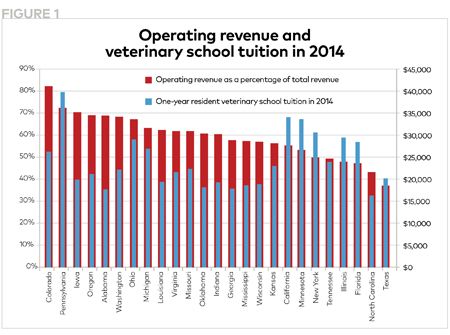The cost of a seat: State funding, vet school tuition and easy assumptions
Its easy to presume that veterinary colleges receiving lots of public support can charge lower tuitionbut is it true? The AVMA Econ team decided to find out.

Shutterstock.comThe level of debt veterinary students carry into their careers has been the subject of much discussion in the profession, along with the unhealthy debt-to-income ratio (DIR) resulting from high debt loads and relatively low starting salaries. A logical question to ask in these conversations is, why does a veterinary education cost so much? And, by extension, why are some veterinary schools so much more expensive than others? The answer, it turns out, is far from simple.
The cost of tuition and fees at all American Association of Veterinary Medical Colleges (AAVMC) member institutions, both domestic and international, is available on the AAVMC website. The four-year cost per seat ranges from roughly $71,000 to just over $145,000 for the 24 U.S. veterinary colleges that offer resident tuition. However, when we look at all seats (resident and nonresident), we see that four-year tuition varies from $71,000 to just less than $254,000.
One explanation that has been offered for this extreme variation is the difference in state funding that each veterinary college receives. The greater the level of state funding (so the theory goes), the lower the tuition and fees will be for a four-year program-and the less student debt graduates will have to take on as a result. This would also explain the large discrepancy between the 25 publicly assisted and five non-publicly assisted colleges of veterinary medicine.
Putting theory to the test
So is this explanation supported by the data? We wanted to find out. First, we looked at public support for all four-year public institutions in the United States. We found that in 2014, public funding as a percentage of total revenue (which also includes student tuition, research grants and so on) for these four-year schools ranged from 15 percent in Colorado to 58 percent in Wyoming, according to the National Center for Education Statistics. In other words, Colorado colleges and universities had the lowest level of public funding support, while Wyoming schools had the highest.
So did those veterinary colleges with a high percentage of public support charge lower tutition and fees? Did those with a low percentage of public support charge higher tuition and fees? No. The proportion of revenue from state appropriations had zero impact on resident tuition and fees charged at U.S. colleges of veterinary medicine.
Figure 1 shows this relationship (or lack thereof)-if you know how to look at it. Public funding is categorized as non-operating revenue; operating revenue is what a school receives in exchange for providing educational services (tuition is an example of operating revenue). So schools with higher operating revenue percentages (red bars) will have lower percentages of non-operating revenue (public funding) and, according to our theory, supposedly charge higher tuition (blue bars). So the slope of blue bars would be expected to reflect the slope of the red bars-and as you can see, it clearly doesn't.

Source: AVMA Veterinary Economics DivisionSo what's really going on?
Because there's no relationship between public support levels and resident tuition rates at the various veterinary colleges, we have to assume that other factors explain the variation in veterinary education costs by college. For one thing, higher education governing bodies may not allocate state appropriations across public institutions equally. In addition, individual institutions don't necessarily allocate public funds across various colleges and programs within the institution equally either.
It's safe to say that, in general, declining public support for all public higher education has contributed to the rise in tuition over the past two decades. But the share of public support each state provides higher education has no relationship to the tuition and fees paid by veterinary students at the 25 publicly assisted veterinary colleges. To identify veterinary colleges with more efficient educational delivery systems, we need more information. This will be important in any efforts the profession makes to reduce the cost of veterinary education.